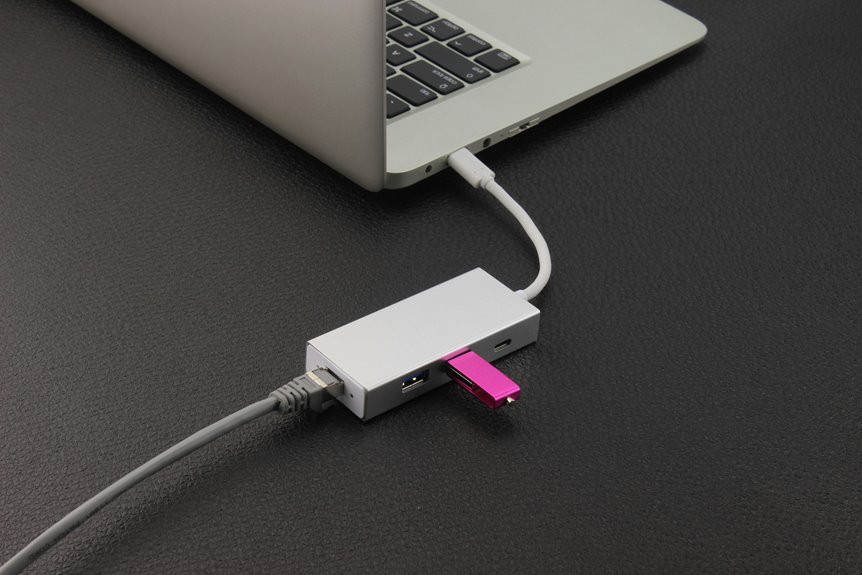To optimize fast internet access, users should consider utilizing Cat6 or higher category Ethernet cables.
Cat6 cables are capable of supporting speeds of up to 10 Gbps, making them perfect for bandwidth-intensive activities such as streaming high-definition content and online gaming.
For those looking to future-proof their networking setup, Cat6a and Cat7 cables provide even greater performance capabilities, featuring enhanced shielding that significantly reduces interference.
Investing in high-quality cables not only ensures stable connections but also enhances overall network reliability.
By understanding the specific features and benefits of these advanced Ethernet cables, users can make well-informed decisions tailored to their unique internet needs and setups.
Understanding Cable Categories and Their Speeds
In the context of selecting the right Ethernet cable, understanding the different categories and their corresponding speeds is vital. Each category offers unique cable bandwidth and speed capabilities, from Cat5e's 1 Gbps at 100 MHz to Cat8's impressive 40 Gbps at 2000 MHz. Higher categories like Cat7 and Cat8 feature improved shielding, greatly reducing signal interference, which is critical in high-speed environments. While Cat5e suits basic needs for home networks and small offices, Cat6a and above excel in data centers, supporting high demands over specified distances. Therefore, selecting the appropriate Ethernet cable hinges on balancing bandwidth requirements, distance limitations, and potential signal degradation. Cat6a's 10 Gbps speeds over 100 meters make it an attractive option for businesses planning for future network expansion. Additionally, Ethernet offers faster options than Wi-Fi for local area networks, which is essential for maintaining high-speed internet access. It's essential to consider the specific applications and future-proofing your network when making a choice, as higher-category cables can accommodate emerging technologies and increasing data traffic.
Choosing the Right Cable for Residential Use
When selecting a cable for residential use, homeowners must consider specific factors that align with their internet needs and environment. For instance, users should evaluate the size of their home, the number of devices connected to the network, and the types of online activities they engage in, such as streaming, gaming, or video conferencing. Cat5e cables are generally sufficient for most users due to their cost-effectiveness and ability to support speeds up to 1 Gbps, making them ideal for standard internet browsing and streaming on a few devices. However, for those with higher bandwidth demands or planning for future upgrades, Cat6 cables offer better shielding, reduced crosstalk, and improved performance, making them a solid choice for maximizing network efficiency and future-proofing against potential speed upgrades.
Additionally, installation tips include using slim, flat cables in tight spaces to optimize routing, especially in areas where aesthetics or space constraints are a concern. It's also advisable to avoid running cables near power lines or sources of interference, as this can degrade signal quality. Regular cable maintenance, such as checking for frays, ensuring secure connections, and keeping cables organized, guarantees longevity and sustained performance, particularly in environments with high interference, such as homes with many electronic devices. Higher MHz indicates more data processed simultaneously, making it essential to consider when choosing a cable for optimal performance. Furthermore, selecting cables with higher categories like Cat 6 or Cat 6a ensures higher bandwidth capabilities, allowing for a better overall internet experience as user needs grow.
Ultimately, selecting the right cable can significantly enhance network efficiency, enabling a seamless experience for streaming, gaming, and other bandwidth-intensive activities. By considering individual needs and future requirements, homeowners can make informed decisions that provide freedom for all their online demands.
High-Speed Internet Plans: Which Cable to Select
When selecting high-speed internet plans, it is crucial to understand the different categories of cables available, as this knowledge is vital for maximizing your internet performance. Key considerations for future-proofing your internet setup will ensure that the chosen cable can accommodate the demands of emerging technologies. Additionally, selecting the appropriate cable length is important to minimize signal degradation, which can adversely affect your connection speed and stability. Together, these factors significantly influence the overall efficiency, reliability, and longevity of your internet connection as technology continues to advance. Notably, choosing a provider like Verizon Fios can enhance the fiber internet experience due to its robust infrastructure and customer satisfaction ratings.
Cable Category Comparison
Selecting the right cable category is vital for maximizing high-speed internet access in both residential and office environments. A thorough cable performance analysis reveals distinct advantages among categories. For instance, Cat5e suffices for basic networks, making it suitable for light internet usage or small home setups. On the other hand, Cat6 offers improved speeds of up to 10 Gbps, making it ideal for general use, including streaming and online gaming.
For more advanced networks, such as those requiring high bandwidth for multiple users, Cat6a and Cat7 provide increased bandwidth and distance support, allowing for better performance in demanding applications. Cat8 stands out in this comparison with exceptional speeds, reaching up to 40 Gbps, making it perfect for data centers or environments that require ultra-fast connectivity.
To guarantee peak performance, adherence to installation best practices is paramount. Proper cable management and installation techniques can significantly enhance cable effectiveness, ensuring that users can fully capitalize on the potential benefits of high-speed internet plans. Additionally, considering future-proofing options when selecting cable categories is essential, as technology continues to evolve and demand for faster internet speeds increases.
Future-Proofing Considerations
To ensure a network can effectively address future demands, it is essential to carefully evaluate cable selection for high-speed internet plans. Choosing cables with enhanced fiber strand scalability allows for increased bandwidth capacity without necessitating additional installations. Additionally, implementing path diversity reduces the risks associated with single points of failure, thereby enhancing reliability. Technologies such as Wavelength Division Multiplexing (WDM) further augment capacity by enabling the transmission of multiple signals over a single fiber strand. Regular maintenance and proactive upgrade planning are crucial in maintaining a robust network that remains compatible with emerging technologies, ultimately empowering users to expand their digital capabilities effortlessly.
To further enhance the article, consider exploring the following queries:
- What are the benefits of fiber optic cables compared to traditional copper cables?
- How does path diversity contribute to network reliability?
- What are the latest advancements in Wavelength Division Multiplexing technology?
- How often should networks undergo maintenance and upgrades?
- What emerging technologies should network planners consider for future-proofing?
- What factors should be considered in selecting cables for varying bandwidth requirements?
- How do scalability and bandwidth affect overall network performance?
Optimal Length Selection
Choosing the ideal cable length is crucial for maximizing network performance in high-speed internet plans. Length flexibility allows users to tailor their setup, but longer cables can introduce signal degradation, compromising speed and reliability. For best performance, Ethernet cables should not exceed 328 feet; however, shorter lengths enhance signal quality. Cat6a cables excel in this regard, maintaining high speeds without significant degradation. Environmental factors, such as interference or physical barriers, further necessitate careful length selection. Users should assess their distance needs, allowing for slack without excessive length that can clutter spaces, ensuring a streamlined and efficient network.
To expand on this topic, consider exploring related queries such as:
- What are the optimal lengths for different types of Ethernet cables?
- How does cable length affect internet speed and reliability?
- What are the benefits of using Cat6a cables over Cat5e or other types?
- How can environmental factors impact network performance?
- What strategies can users implement to minimize signal degradation?
- How should users calculate their required cable length based on their setup?
- What are the common issues associated with using excessively long Ethernet cables?
- How do physical barriers in an environment affect network signal strength?
- What are the best practices for organizing Ethernet cables in a workspace?
- What tools can help measure and determine the appropriate cable length for specific installations?
These queries can lead to a more comprehensive understanding of optimal cable length selection and its impact on network performance.
Future-Proofing Your Network With Advanced Cables
To future-proof a network, it is essential to choose higher category cables such as Cat 6A or Cat 7, which are designed to support increased speeds and bandwidth capabilities. Additionally, the selection of appropriate shielding types is vital in order to reduce interference and improve overall signal integrity. By investing in advanced cabling solutions, organizations can achieve long-term cost efficiency, minimizing the need for frequent upgrades as technological advancements occur. Furthermore, exploring options like fiber optic cables may also enhance network performance and reliability in the long run.
Choosing Higher Category Cables
As technology continues to develop, selecting higher category cables becomes essential for ensuring a robust and future-proof network. Higher category cables, such as Cat6a, Cat7, and Cat8, significantly enhance cable performance by supporting greater speeds and bandwidth, making them ideal for demanding environments like data centers and high-performance computing setups. Installation tips to consider include ensuring proper terminations, using high-quality connectors, and minimizing cable length to optimize performance and reduce signal loss.
While Cat5e may suffice for current gigabit needs, investing in higher categories prepares networks for future demands, accommodating advancements in technology and increasing data traffic. Although the initial cost of higher category cables may be more expensive, they can lead to long-term savings by reducing the frequency of upgrades and maintenance, ultimately improving network flexibility, reliability, and longevity. By choosing the right cabling, organizations can ensure their infrastructure remains capable of supporting evolving applications and services.
Benefits of Shielding Types
While many might overlook the importance of cable shielding, its benefits in enhancing network performance and reliability should not be underestimated. Shielded cables provide significant advantages in shielding, ensuring robust communication and data integrity. The key benefits of using shielded cables include:
- Reduced Interference: Effectively minimizes electromagnetic disruption, which leads to improved signal quality and clarity.
- Minimized Crosstalk: Significantly boosts data flow reliability between adjacent cables, reducing the risk of data corruption.
- Augmented Security: Offers protection against data leakage that may occur due to electromagnetic emissions, safeguarding sensitive information.
These advantages not only enhance the durability of cables but also equip networks to meet future demands, making shielded cables essential for environments that are susceptible to interference and require high-bandwidth capabilities. Additionally, their implementation can lead to more efficient network management and a reduction in maintenance costs over time.
Long-Term Cost Efficiency**
Investing in advanced cabling solutions significantly enhances long-term cost efficiency for network infrastructures. Utilizing bulk Ethernet cables can yield substantial savings, with costs decreasing by 20% to 80%, making them particularly advantageous for larger installations. On the other hand, fiber optic cables provide exceptional performance longevity, offering over 1,000 times the bandwidth of traditional copper cables, which reduces the frequency of necessary upgrades. Their inherent durability and resistance to environmental factors further decrease maintenance expenses, while optimized network configurations lead to minimized downtime. Collectively, these attributes foster a sustainable network solution, designed to adapt to future demands without increasing operational complexity or costs. This makes advanced cabling a wise investment for organizations that prioritize forward-thinking strategies.
Features to Consider When Buying Ethernet Cables
When selecting Ethernet cables, several key features greatly impact performance and compatibility. Buyers should consider:
- Cable Materials: Opt for pure copper over CCA for superior performance; solid conductors work best for permanent installations, while stranded ones offer flexibility. Understanding the differences in conductivity and durability can further guide your choice.
- Data Rates: Choose cables like Cat5e for 1 Gbps or Cat6a for higher speeds. Higher category cables, such as Cat6 or Cat7, can support even greater speeds and bandwidth, ensuring your network is future-proofed as technology evolves.
- Installation Tips: Thinner cables simplify installation, making them ideal for tight spaces or networking in residential settings. Additionally, consider shielding options for environments with high electromagnetic interference to maintain signal integrity and reduce potential disruptions.
These factors collectively enhance network performance and guarantee compatibility with a diverse range of devices, promoting ideal fast internet access across different setups and applications.
Recommended Brands and Where to Buy
Selecting the right Ethernet cable brands is essential for optimizing both performance and reliability in your network setup. DbillionDa is highly regarded for its CAT 8 cables, offering impressive speeds of up to 40Gbps, making it ideal for high-bandwidth applications. For those seeking durable options, DanYee and Jadaol provide robust CAT 7 cables that support speeds of 10Gbps, suitable for most home and office environments. UGREEN is known for its excellent extension cables, perfect for extending your network reach without compromising speed. If you're on a budget, Amazon Basics offers affordable alternatives that still deliver decent performance.
When it comes to purchasing, Amazon is a top destination for a wide variety of Ethernet cables, but Newegg and HighSpeedInternet.com also provide competitive pricing and insightful user reviews to help you make informed decisions. To ensure optimal performance, consider installation tips such as maintaining proper cable management and avoiding tight bends, which can enhance cable durability and performance. By selecting reputable brands and adhering to best practices during installation, users can significantly enhance their internet access and overall network experience.





